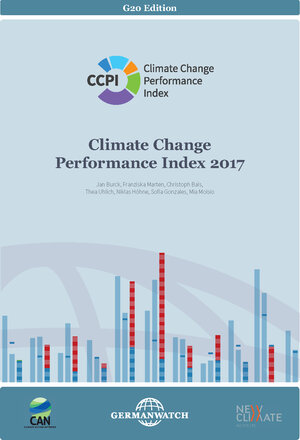
×
![Buchcover ISBN 9783943704556]()
Emitting about 75% of global greenhouse gas
(GHG) emissions and 82% of global energy-related
CO2 emissions (2014), the G20 as the 20 biggest
economies have a particularly high responsibility in
leading the world towards success in limiting global
warming to well below 2°C, if not 1.5°C, as agreed to
in the Paris Agreement in 2015. With its new methodology,
the Climate Change Performance Index
(CCPI) is now suited to measure the progress of
countries towards contributing to the climate goals
agreed to in Paris. The global response to Donald
Trump’s plans to pull the USA out of the Paris Agreement
was encouraging and strengthened hope that
new competitive technologies as well as knowledge
about the dangerous effects of the rise in global
temperature are the basis for the global community
to implement the Pairs treaty. Even domestically,
the President’s decision was countered by a strong
coalition of states, towns and businesses who announced
measures to fulfil the US pledge under the
Paris Agreement. They expect the new policy of the
US federal government to fail, being convinced that
climate protection could be perfectly aligned with
economic development and renewables would already
be the better business model.
This assumption is underlined by the data, which
shows massively growing investments in renewables,
leading to double-digit growth rates for
renewables already for some years already. In
2016, renewables exceeded fossil fuels not only in
investments but for the first time also in newly installed
capacity; renewable technology has already
reached market parity.
At the same time, the Trump administration seems
isolated in its attempt to revive its coal industry.
Other countries have turned their back on coal,
some in an attempt to fight bad air quality in their
cities, others driven by economic factors. The new
Korean (Rep.) president announced the closure of
coal-fired power plants, China has reversed plans
for new coal plants to be built, India is re-evaluating
plans for the expansion of coal and, some European
countries acknowledged the need to phase
out coal completely in the medium term.
While recognizing the significance of this development,
it is important to also note that data as well
show very few countries - especially in the G20 - on
a pathway to well below 2°C, neither in their current
performance nor in their targets for 2030. Countries
have to prove they are willing to follow through
with implementing the necessary policies to reach
national mitigation targets and raise ambition in
adapting their targets to what would be compatible
with well below 2°C.
(GHG) emissions and 82% of global energy-related
CO2 emissions (2014), the G20 as the 20 biggest
economies have a particularly high responsibility in
leading the world towards success in limiting global
warming to well below 2°C, if not 1.5°C, as agreed to
in the Paris Agreement in 2015. With its new methodology,
the Climate Change Performance Index
(CCPI) is now suited to measure the progress of
countries towards contributing to the climate goals
agreed to in Paris. The global response to Donald
Trump’s plans to pull the USA out of the Paris Agreement
was encouraging and strengthened hope that
new competitive technologies as well as knowledge
about the dangerous effects of the rise in global
temperature are the basis for the global community
to implement the Pairs treaty. Even domestically,
the President’s decision was countered by a strong
coalition of states, towns and businesses who announced
measures to fulfil the US pledge under the
Paris Agreement. They expect the new policy of the
US federal government to fail, being convinced that
climate protection could be perfectly aligned with
economic development and renewables would already
be the better business model.
This assumption is underlined by the data, which
shows massively growing investments in renewables,
leading to double-digit growth rates for
renewables already for some years already. In
2016, renewables exceeded fossil fuels not only in
investments but for the first time also in newly installed
capacity; renewable technology has already
reached market parity.
At the same time, the Trump administration seems
isolated in its attempt to revive its coal industry.
Other countries have turned their back on coal,
some in an attempt to fight bad air quality in their
cities, others driven by economic factors. The new
Korean (Rep.) president announced the closure of
coal-fired power plants, China has reversed plans
for new coal plants to be built, India is re-evaluating
plans for the expansion of coal and, some European
countries acknowledged the need to phase
out coal completely in the medium term.
While recognizing the significance of this development,
it is important to also note that data as well
show very few countries - especially in the G20 - on
a pathway to well below 2°C, neither in their current
performance nor in their targets for 2030. Countries
have to prove they are willing to follow through
with implementing the necessary policies to reach
national mitigation targets and raise ambition in
adapting their targets to what would be compatible
with well below 2°C.


